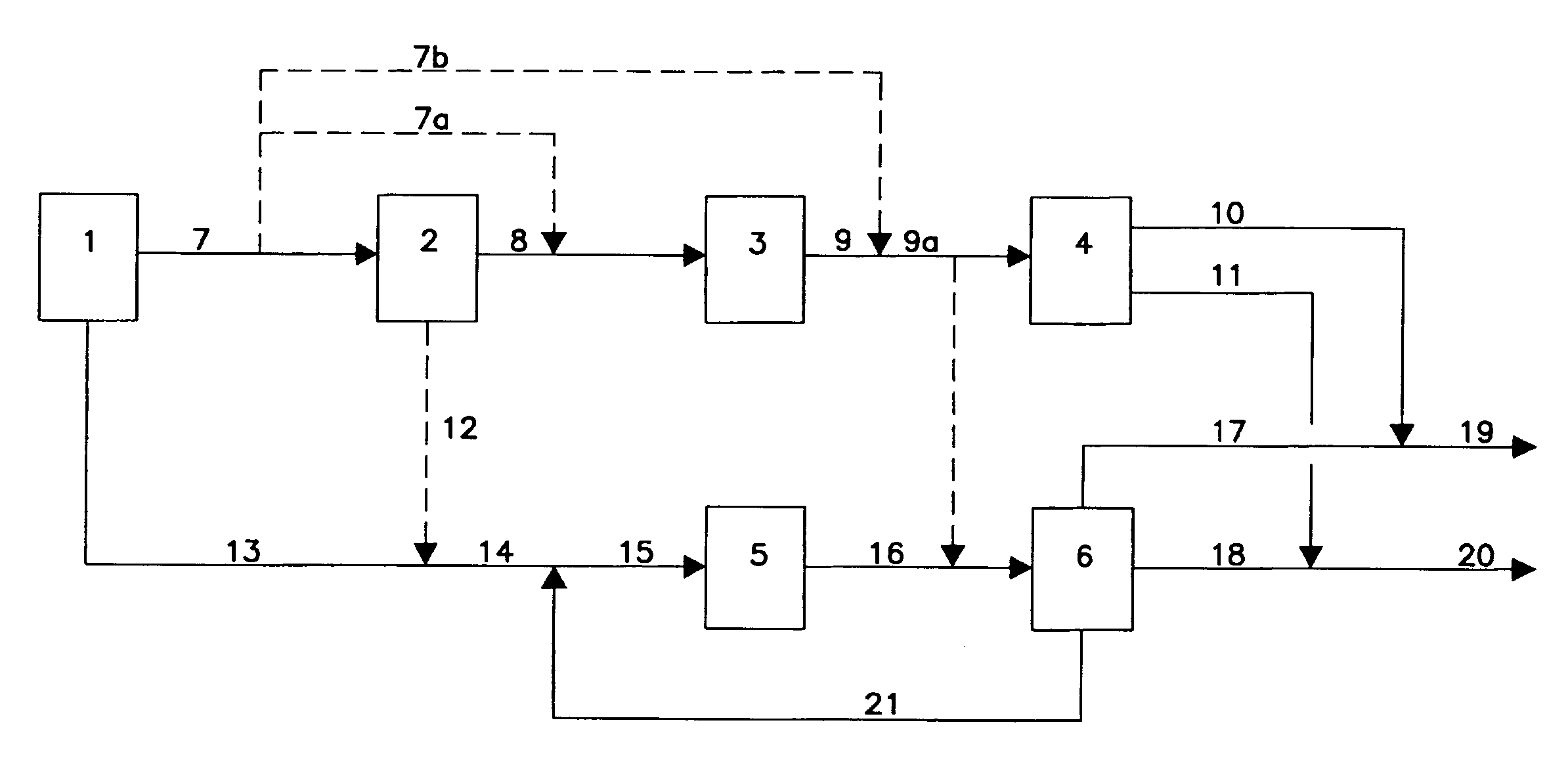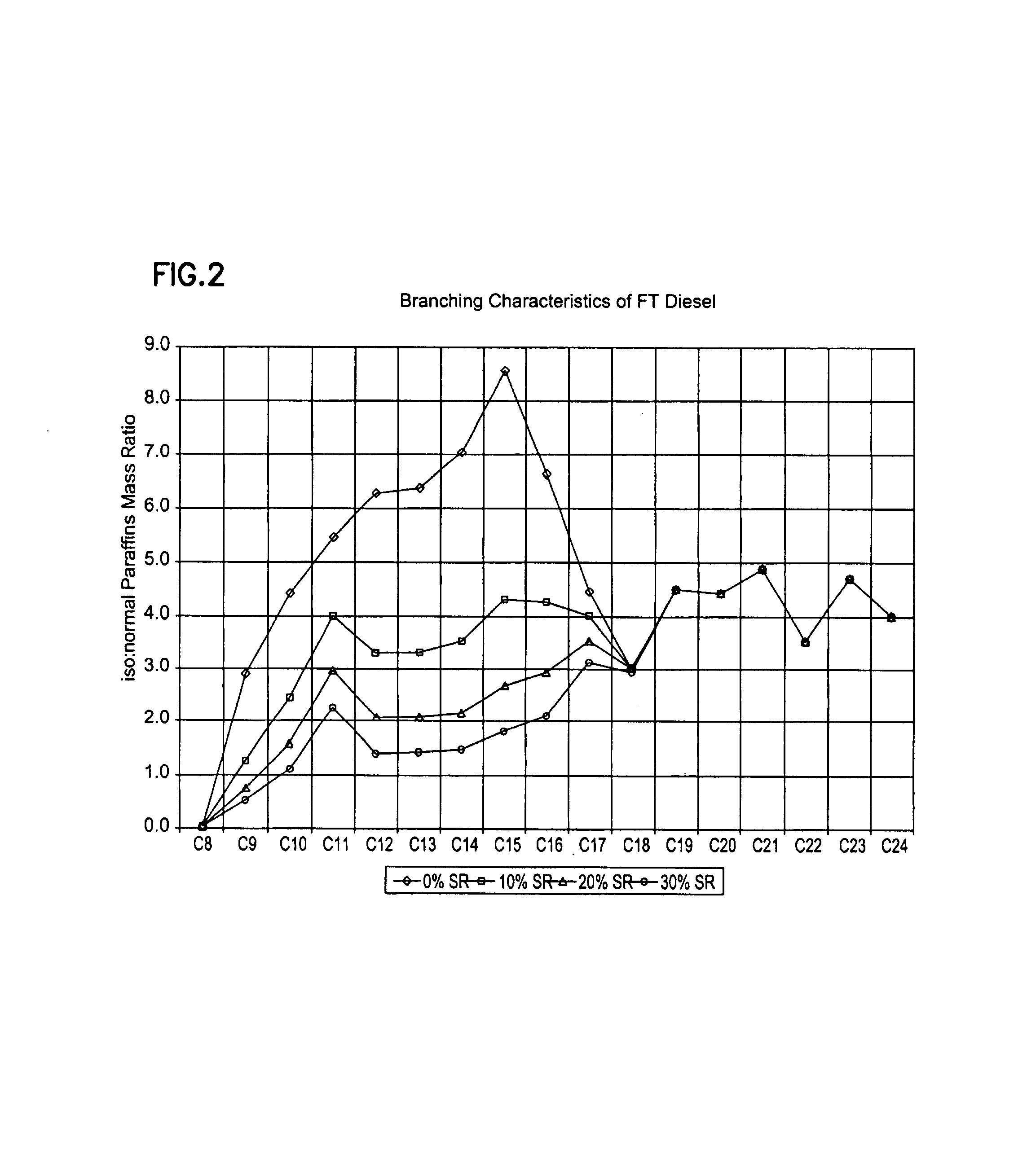Process for producing middle distillates
a technology for distillates and distillates, applied in the field of middle distillates, can solve the problems of reducing the yield of valuable distillates, difficult use of products, and notoriously poor cold flow properties, and achieve the effect of high cetane number and good cold flow properties
- Summary
- Abstract
- Description
- Claims
- Application Information
AI Technical Summary
Benefits of technology
Problems solved by technology
Method used
Image
Examples
example 1
[0093]A commercially available hydrocracking catalyst was used for hydrocracking of a non-hydrotreated FT hydrocarbon fraction with an initial boiling point of about 280° C. The active metals on the catalyst comprised cobalt and molybdenum, while the support was amorphous silica-alumina. Operating conditions were temperatures between 375 and 385° C., pressure of 70 bar and hydrogen flow rate of 1500 m3n / m3 feed. The experiment was carried out in a pilot plant reactor. The conversion of>370° C. material to lighter material ranged between 65 and 80%. Diesel component A is obtained after fractionation of the reactor products. The properties of this diesel component are given in table 1.
example 2
[0094]A non-hydrotreated FT hydrocarbon fraction with a final boiling point of ca 285° C. and alcohol content of ca. 4.3 mass %, expressed as n-hexanol, was rigorously hydrotreated using a commercially available catalyst. The active metals on the catalyst comprised molybdenum and cobalt, while the support was alumina. The process conditions were temperatures around 250° C., pressure of 68 bar and hydrogen flow rate of 1070 m3n / m3 feed. The test was carried in a commercial scale fixed bed reactor. Diesel components B and C were obtained after fractionation of respectively the reactor feed and reactor product. The properties of these diesel components are given in table 6.
[0095]
TABLE 6Diesel Blending ComponentsComponentComponentComponentABCASTM D86 distillationIBP, ° C.18516118610%, ° C.21118819850%, ° C.26922422390%, ° C.338263259FBP, ° C.361285279Density, kg / dm3 @ 20° C.0.77660.76410.7515Viscosity, cSt @ 40° C.2.661.811.54Flash Point, ° C.766172Cold Filter Plugging Point,−32−18−17° ...
example 3
[0096]The diesel fraction obtained from hydrocracking a heavy FT material (component A) was blended with a hydrogenated lighter FT material (component B) in a volume ratio of 84:16. The properties of the final blend, called Blend I, are given in table 7.
[0097]Those skilled in the art will realize that Blend I may be used on its own, but also as a blending feedstock. The combination of a high Cetane numbers, above 70, and excellent cold flow properties, with CFPP substantially better than −20° C., make Blend I an ideal blending feedstock to upgrade crude oil derived diesels.
PUM
| Property | Measurement | Unit |
|---|---|---|
| mass ratio | aaaaa | aaaaa |
| pressure | aaaaa | aaaaa |
| temperatures | aaaaa | aaaaa |
Abstract
Description
Claims
Application Information
 Login to View More
Login to View More - R&D
- Intellectual Property
- Life Sciences
- Materials
- Tech Scout
- Unparalleled Data Quality
- Higher Quality Content
- 60% Fewer Hallucinations
Browse by: Latest US Patents, China's latest patents, Technical Efficacy Thesaurus, Application Domain, Technology Topic, Popular Technical Reports.
© 2025 PatSnap. All rights reserved.Legal|Privacy policy|Modern Slavery Act Transparency Statement|Sitemap|About US| Contact US: help@patsnap.com



